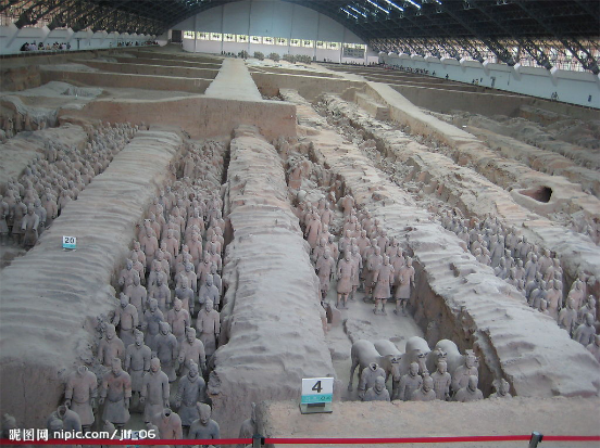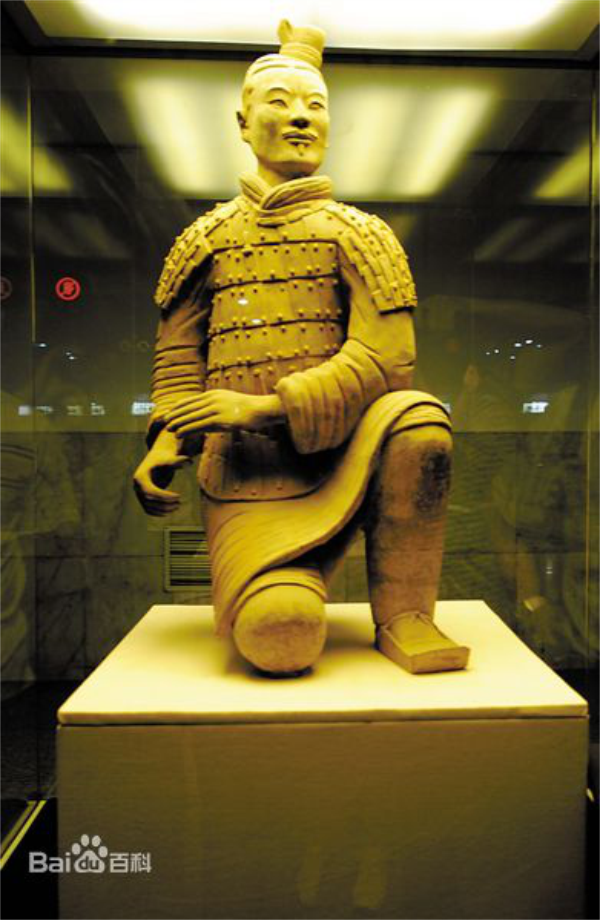Mausoleum of Emperor Qin Shihuang and the Terra Cotta Warriors and Horses
Due to the brief history and secluded location, the State of Qin was regarded by other states in the Spring and Autumn Period and the Warring States Period as a backward place. However, influenced by the value system emphasizing personal interests and exploits while overlooking ethics, the Qin People were progressive and hardworking, stressing techniques and applied skills, which enabled the State of Qin to lead other eastern states in applied science for quite a long time. In the Spring and Autumn Period, for example, quite a great number of well-known doctors such as Yi Huan and Yi He were Qin natives which made the State of Qin a medical shrine at that time. Apart from achievements in medicine, the State of Qin was also advanced in a number of other aspects of science and technology, which is vividly reflected by the world-famous Mausoleum of Emperor Qin Shihuang and the Terra Cotta Warriers and Horses.

The Mausoleum of Emperor Qin Shihuang
As one famous ruler in the Chinese history, Emperor Qin Shihuang left us not only many invisible heritages in terms of politics, economy and ideology, but also a huge treasury of great mystery—the Mausoleum of Emperor Qin Shihuang.
In ancient China, the king held supreme status and therefore could use all the financial resources for his own interests. Emperor Qin Shihuang not only built for his daily activities a massive Xianyang City with the imposing Epang Palace, but also a spacious and gorgeous tomb for his afterlife. To build the tomb, the emperor called up more than 100,000 laborers to work for 38 years. Archeological excavation revealed that the tomb sections were generally arranged in ambulatory rectangles with two layers of walls surrounding the tomb site. The inner wall extended for 3870m and the outer wall 6210m. With a coverage amounting to 56.25km2, the mausoleum still presents us a grave mound of 76 meters tall after the 2,000 years erosion of rains and winds. Housing various priceless treasures, the mausoleum is unprecedented in its scale of construction and collection of cultural relics. The Terra Cotta Warriors and Horses pits, for instance, were entitled “the Eighth World Wonder”, but they constitute merely one small part of the entire mausoleum. Therefore, we can never imagine how magnificent the entire mausoleum would look originally and it deserves the title of “World Cultural Relic” granted by UNESCO in Dec. 1987.
The Warrior and Horse pits were first found in Lintong County, east of Xi’an City by a couple of peasants when they were digging a well. Further excavation by archeologists and extensive reports covering its discovery made it well-known throughout the world. Its massive historic value was gradually realized and visitors from various countries swarmed to China for a glance of this world wonder. With more than two million visitors visiting the museum each year, the Museum of Terra Cotta Warriors and Horses ranks first among all Chinese museums in terms of visitor reception. For merely two decades, more than 40 million visitors came here. Among them, around 200 are national leaders and governmental officials, including four presidents of the United States, the Queen and Prime Minister of the Great Britain etc. After Charles de Gaulle, four other presidents of France paid a visit there. Among them Jacques Chirac visited the museum for three times. Chirac was enthusiastic about Chinese culture and was the first foreign leader to witness the Terra Cotta Warriors and Horses when he paid a state visit to China in 1978. During his visit, he exclaimed over the splendor of these sculptures and highly praised it as the eighth wonder of the world since there were already seven wonders discovered till then. Chirac’s praise was extensively cited by various media which helped introduce the museum to the world. Recently, the Terra Cotta Warriors and Horses have become the business card of Xi’an, Shaanxi and even China to the outside world and it can be safely said that “people who haven’t been to Xi’an can not claim to have been to China and people who haven’t seen the Terra Cotta Warriors and Horses can not claim to have been to Xi’an”.
The Mausoleum comprises three pits, which distribute on an area of about 40,000m2 with the three pits covering at least 20,000m2. There are altogether 7,000 to 8,000 warriors and horses, a large collection of sculptures matchless in the world. Besides, all the pottery figures and horses are of life size, with the average height of figures being 1.8m and that of horses 1.5m. Therefore, the Terra Cotta Warriors and Horses Mausoleum of Emperor Qin Shihuang are unprecedented in the sculpture history of China. This explains why the mausoleum is entitled to various international honors and it is the only archeological finding in China winning the laurel of “World Top Ten Archeological Findings”.

No. 1 Pit of Terra Cotta Warriors
The pottery warriors and horses not only illustrate the national strength of the Qin Empire and the morale of soldiers at that time, but also reflect the exquisite techniques of sculpture in the Qin Empire. In terms of artistic value, the sculpture heralded realism in Chinese carving and sculpture. The warriors and horses are not only of life size but also of similar style in the outfit and appearance. On the figures you can see vividly carved hair styles, leather straps connecting the armor pieces and the copper hooks on the belt. Moreover, you can even see such detailed items as the leggings, shoelace and even stitches on the sole, all vividly carved according to the actual style. On the horse you can also find the saddles, which are carved with every detail. Meanwhile, you can see different facial expressions and appearance, which vividly present to us a troop of soldiers with high morale. These figures are so vividly carved that we can even detect some minority ethnic groups from their exotic facial bone structure. Overall, the figures are mostly strong and high-spirited which present us the artistic pursuit of grandness in the Qin Dynasty.

Kneeling Archer
Emperor Qin Shihuang launched the notorious suppression of the literates by burning literary works and burying alive Confucian scholars, which resulted in the neglect of his exploits in the field of art. Therefore, for about 2,000 years, people withheld no doubt about Emperor Qin Shihuang’s splendid military exploits but seldom had people realized his contribution to culture and arts. The excavation of the Terra Cotta Warriors and Horses, however, testified the unprecedented glory achieved in the field of art in the Qin Dynasty. The sculptures illustrate the epoch-making success scored by the Qin People, which subverted the traditional belief that Qin culture was backward and therefore changed the Chinese art history and even the world art history.
Besides contribution to the Chinese art history, the bell with the inscription of yue fu excavated near the mound of the mausoleum in February 1976 also helped rewrite the music history in China. The bell is 13cm tall with inlaying gold veins, which reflects the mature and exquisite techniques in bronze casting in the Qin Dynasty. The two characters “yue fu” on the bell was the only evidence to testify the existence of yue fu, the government office for collecting folk songs and ballads in the Qin Dynasty. For hundreds of years, it had been settled belief that yue fu was started by Emperor Wudi of the Han Dynasty in the Chinese music history, the literary history and even the official ranking system history. The bell, however, provided indisputable evidence for the existence of yue fu in as early as the Qin Dynasty, and therefore yue fu in the Han Dynasty was only a continuation of the organization of Qin. A mere inscription of two characters helped unravel a mystery for two thousand years, which fully exemplifies the Chinese idiom “one character being worth as much as 1,000 taels of gold”.

yue fu Bells which rewrite Chinese music and literary history
The bronze weapons and other relics also fully demonstrate the highest level of various techniques. The bronze arrowheads unearthed in the pits are triangular pyramid-shaped with three streamlined edges. These arrowheads fall into five size categories with arrowhead in each size group showing an undetectably minor error of only 0.15mm which can only be noticed when magnified 20 times larger with special measuring projector. Moreover, all the components of the crossbow are of like size and interchangeable. Since precision in measurement was not only achieved until the recent assembly lines, we cannot help marveling at the precision requirement in the Qin Dynasty.
The rust-proof treatment of the surface of the bronze weapons is more surprising, for the bronze weapons were glimmering like newly-made ones when unearthed 2,000 years later. Modern tests prove that the bronze weapons are covered with a 0.01mm layer of chromic salt oxid containing 2% chromium. Chromic salt was recorded to be firstly adopted by a German in 1937 to prevent rusting, for which he applied a patent, but the Qin People adopted it 2,000 years ago, which persuades the western world in believing that it is really a wonder in science history.
The bronze manufacturing techniques are best reflected in the bronze carriages excavated in the Mausoleum of Emperor Qin Shihuang. The bronze carriage and horses is another major finding after “the Eighth World Wonder”—the Terra Cotta Warriors and Horses and they are the most glorious and valuable cultural relics found from the Qin Mausoleum till recently. Unearthed in 1978, the two carriages weigh almost 2.5 tons and were marked with numbers according to the sequence of their excavation. Carriage No.1 is a guarding vehicle for clearing the way and carriage No.2, being one of 81 large-sized vehicles used by the emperor, is comparatively larger in size. These two carriages are made with exquisite techniques and relic repair experts calculated that the imperial vehicle alone comprises 3,962 joints with 3,173 removable joints and 609 welded, locked or cast joints, among which 182 joints have patterns carved on them. All these parts can be easily connected according to their shapes and functions. Dug out from under earth 2,000 years later, most joints can still be effectively connected and many of them are interchangeable or of same size, which reflects the standardization in manufacturing. Seeing the reasonable design and intricate structure of the carriages, welding experts can not help marveling at the manufacturing techniques which are similar in many ways to the modern techniques in manufacturing. If the mysterious bronze vessels in the Western Zhou Dynasty marked the splendor of the bronze manufacture in China, the splendid and exquisite bronze carriages undoubtedly represent the perfection of bronze culture, which put a perfect full stop for the Bonze Age lasting for 1,700 years in China.

Top Bronze Ware—the bronze carriage and horses
As one of the few world level cultural heritages and one matchless underground treasury of cultural relics, the Mausoleum of Emperor Qin Shihuang is one of the most attractive tourism destinations for foreign visitors to understand Chinese culture and civilization. In 2010, RMB 800 million were invested in a large Historic Site Garden covering 3000mu (2,001,000m2) built on the basis of the mausoleum, which will serve as an important arena showcasing the culture of the Qin Dynasty to visitors throughout the world.


